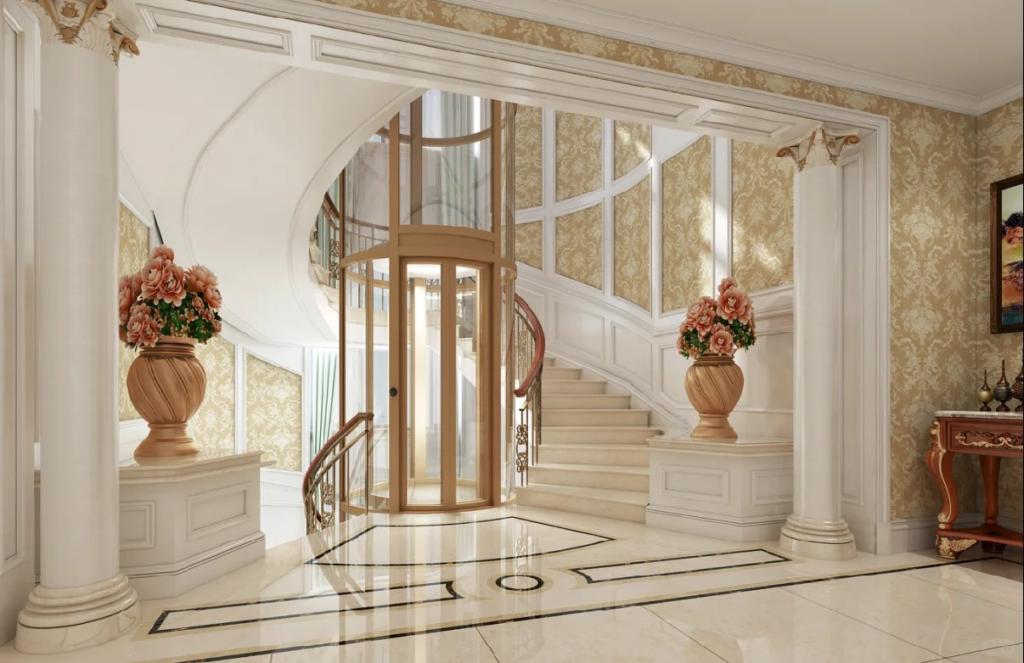Technical Principles and Core Advantages: Redefining Vertical Mobility
The vacuum elevator for home operates on a pressure differential mechanism, replacing traditional cable-driven systems. By evacuating air from the top of a sealed tube, atmospheric pressure at the bottom propels the cabin upward, while pressurizing the top facilitates descent19. This design eliminates the need for pits, machine rooms, or cables, requiring only a 1㎡ floor opening and modular tube assembly, with installation completed in as little as three days.
Key advantages include:
Space Efficiency: Minimal footprint suits villas, duplexes, and retrofits, particularly where structural constraints prohibit traditional elevators;
Energy Savings: Operates on pneumatic power, consuming 70% less energy than conventional models, with manual safety protocols during power outages;
Portability: Lightweight materials (e.g., aerospace-grade aluminum) allow disassembly and relocation, offering "elevator mobility".
The transparent tube design enhances aesthetic integration into modern homes while providing panoramic views.

Global Market Dynamics: Adoption and Challenges
Since PVE (USA) commercialized the first vacuum elevator for home in 2002, over 10,000 units have been installed across 80+ countries, targeting luxury residences and aging-in-place renovations. By 2025, the global home elevator market is projected to exceed ¥100 billion, with vacuum technology dominating emerging markets due to its retrofit-friendly design.
Regional Insights:
Americas & Europe: Mature markets led by PVE and VE Australia, with installation costs ranging from ¥600,000 to ¥1 million, primarily serving high-end homes;
Asia-Pacific: Surging demand in China and India faces localization hurdles. Taiwanese firm GFC and mainland agents like Yuncheng leverage imported models, awaiting domestic R&D breakthroughs to reduce costs;
Africa & Latin America: Nascent markets with growth potential in self-built housing sectors.
Challenges:
High Costs: Import reliance inflates prices, necessitating material localization and mass production;
Safety Perceptions: Despite multi-layered safeguards (e.g., electromagnetic locks), public skepticism persists, requiring stricter certifications and education;
Competition: Traditional giants like Otis and Schindler advance machine-room-less models, urging vacuum innovators to differentiate through AI and sustainability.

Future Outlook: Intelligence and Sustainability
Driven by smart homes and carbon neutrality, the vacuum elevator for home is evolving through:
AI Integration: Optimizing pressure regulation via machine learning, enabling voice control and IoT connectivity;
Eco-Materials: Solar-powered pumps and low-VOC interiors cut emissions by 40% compared to conventional elevators;
Enhanced Safety: Millimeter-wave radar detects occupant movements, while fail-safe mechanisms like "star-sealing technology" prevent free-fall incidents.
By 2030, vacuum elevators for home are expected to capture 25% of the global market, becoming pivotal in smart city infrastructure and urban renewal projects.

Vacuum elevators for home are redefining vertical mobility through technological and ecological innovation. As global adoption accelerates, they promise to transform urban living, symbolizing the convergence of smart homes and sustainable societies





